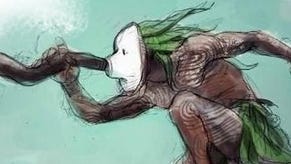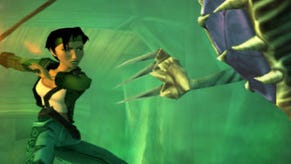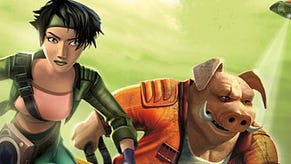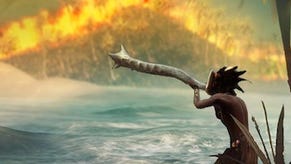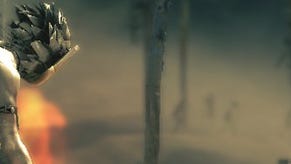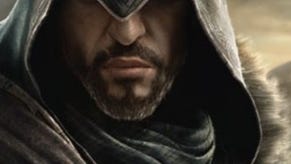First impressions and screens of Eric Chahi's From Dust
Ubisoft president Yves Guillemot took to the stage at E3 last year to announce a new digital title called Project Dust. A small trailer was shown during the event, which from our perspective looked quite sad, but beautiful at the same time. Fast forward a few months later, we were finally able to get our hands on the first three levels of this stunning sandbox god-game, as well as chat with creative director Eric Chahi.
A relationship between man and nature
Playing Black and White as a teenager, I developed a lot of sympathy for God (my atheistic leanings notwithstanding). If it's this hard to keep people happy without impacting upon their free will, I thought, dashing between starving villages that had become over-reliant on my help and warring tribes that wouldn't stop slaughtering each other, no wonder He has abandoned us. From Dust, happily, is free of such frustrations – rather than a game about the relationship between man and God, it's about the relationship between man and the natural world.
From Dust is about a tribe that has lost its memory – a tribe devoid of culture, of history, of tradition, the foundations of identity and civilisation– and at the mercy of hostile forces of nature. In an effort to reclaim their history, the tribe performs the only ritual that it can remember and summon you – a mysterious force known as the Breath – to aid them by manipulating the very earth they stand upon.
After the summoning ritual, you appear as a black orb trailed by a bright, shimmering comet-tail; in other words, a creatively-presented cursor. By holding the left trigger, you suck up great orbs of earth, water or lava, and deposit them elsewhere with the right trigger. The environment morphs and adapts in real-time – running waters don't wait patiently for you to finish building a dam, but spill over the sides of your earthen barriers, quickly eroding them back to nothing.
Lava turns quickly to rock in water, making a more effective barrier than loose earth, but on land it burns vegetation, spreading destructive fire quickly across a whole island. You can create lakes in an instant by dropping enough water into a hollow, or form waves that crash against the shores of newly-created islands.
It's like a beautiful, living nature diorama, constantly changing and evolving at a vastly accelerated rate. Earth erodes, letting trickles of water through that fast create deltas, and as lava solidifies into rock in the water at the foot of a volcano, peninsulas begin to form. You can go away for an hour or few and come back to find that there are several new rivers, or a volcano has spewed so much lava into the sea that it's created a bridge for itself and burned down your villages.
Totems are more than a stipulated ancestor
But there are more concrete goals. By guiding tribespeople to ancient totems, you can reawaken ancient powers that make protecting them from nature an easier ask. They build villages on relatively secure sites, and vegetation spills forth from populated areas and spreads across the whole area. After a while, animals even show up – although the ones I see are terrifyingly huge slug-like amphibious woodlouse things, which aren't exactly an attractive addition to the scenery.
The main aim, then, is to create paths for people to get them to new totems however you can – but you have to think ahead. Dam up a river to create a bridge, and the water might find a new route and destroy a village further away. Lava is a particularly dangerous material to use. Some totems awaken useful supernatural techniques – like the ability to turn water into jelly, letting you part the seas for your tribespeople to walk across the ocean floor.
The main threats to their welfare are huge-scale natural disasters. The sea, particularly, is a cruel force, with great, powerful waves that easily obliterate unprepared settlements. From Dust's prominent featuring of tsunamis is more than a little unfortunate at the moment, so more detailed description doesn't feel appropriate. For all its beauty, From Dust's nature can be frightening. The third environment we see is made up of cruel, jutting black rock, created by a darkly bubbling volcano that violently judders the earth with every eruption.
Not just another god-game
The thing that distinguishes From Dust from every other god game I've ever played is that you interact entirely with the world as opposed as to with the tribe themselves. Manipulating nature is the centrepiece feature – it's almost as if the tribe was added in to give that sandbox experimentation a more game-like structure.
Creative Director Eric Chahi insists that was not in fact the case. “Actually it was the other way around,” he says. “The core idea was to create a game where you have to help a tribe to survive in a fast-changing world with much natural danger – that idea was there from the beginning – but it was only just over a year ago that we formed the idea of interacting directly with the terrain, and the game's been in development for three years.
“At first, the player interacted directly with the people, moving between different places and using different powers, but that was difficult to play, not so much fun.”
Given its production values and size – Chahi reckons there are about 15 hours of play in From Dust, including both the main single-player and another mode that we're not allowed to know about yet – it could easily stand up as a boxed product. But releasing it as a digital download, he says, has given him and his team the creative flexibility that they needed. “It was difficult to keep the creative side intact if we went for a bigger production, so we prefer to have a small team and have more creative freedom, even if that means restrictions regarding the budget.”
There's another distinct advantage from our point of view: From Dust won't cost as much for us to buy. It's at the premium end of the PSN/XBLA spectrum (Chahi says it won't cost less than 15 euros), but still far less expensive than it would otherwise have been. It's due out before the end of the year.





